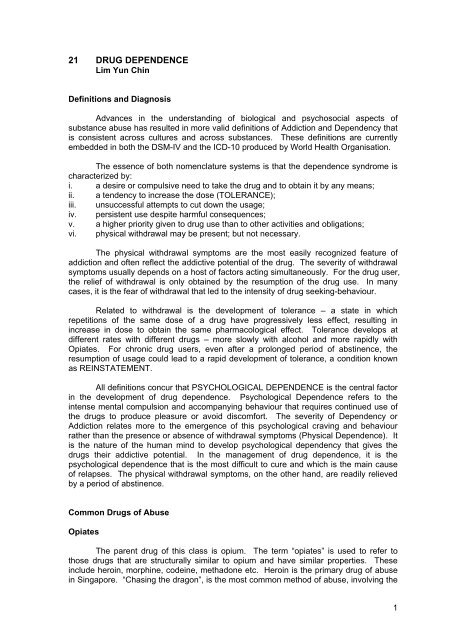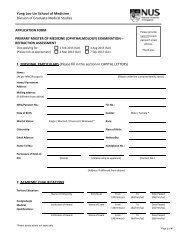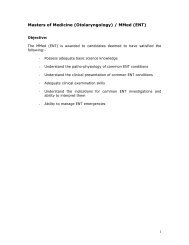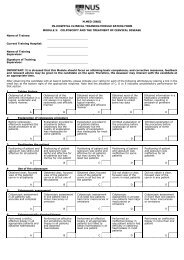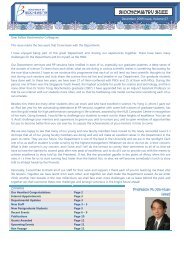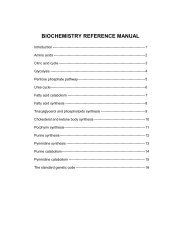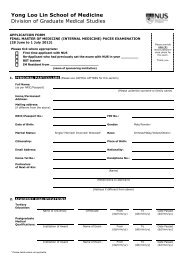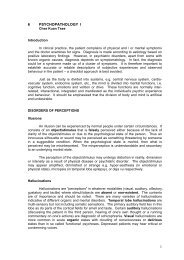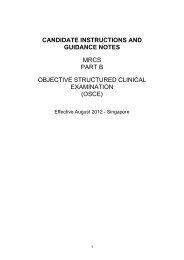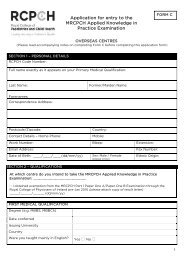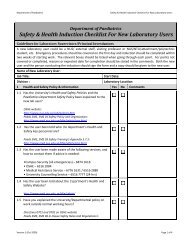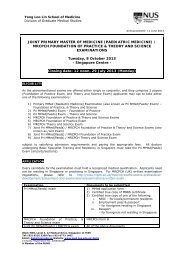21 DRUG DEPENDENCE
21 DRUG DEPENDENCE
21 DRUG DEPENDENCE
You also want an ePaper? Increase the reach of your titles
YUMPU automatically turns print PDFs into web optimized ePapers that Google loves.
<strong>21</strong> <strong>DRUG</strong> <strong>DEPENDENCE</strong>Lim Yun ChinDefinitions and DiagnosisAdvances in the understanding of biological and psychosocial aspects ofsubstance abuse has resulted in more valid definitions of Addiction and Dependency thatis consistent across cultures and across substances. These definitions are currentlyembedded in both the DSM-IV and the ICD-10 produced by World Health Organisation.The essence of both nomenclature systems is that the dependence syndrome ischaracterized by:i. a desire or compulsive need to take the drug and to obtain it by any means;ii. a tendency to increase the dose (TOLERANCE);iii. unsuccessful attempts to cut down the usage;iv. persistent use despite harmful consequences;v. a higher priority given to drug use than to other activities and obligations;vi. physical withdrawal may be present; but not necessary.The physical withdrawal symptoms are the most easily recognized feature ofaddiction and often reflect the addictive potential of the drug. The severity of withdrawalsymptoms usually depends on a host of factors acting simultaneously. For the drug user,the relief of withdrawal is only obtained by the resumption of the drug use. In manycases, it is the fear of withdrawal that led to the intensity of drug seeking-behaviour.Related to withdrawal is the development of tolerance – a state in whichrepetitions of the same dose of a drug have progressively less effect, resulting inincrease in dose to obtain the same pharmacological effect. Tolerance develops atdifferent rates with different drugs – more slowly with alcohol and more rapidly withOpiates. For chronic drug users, even after a prolonged period of abstinence, theresumption of usage could lead to a rapid development of tolerance, a condition knownas REINSTATEMENT.All definitions concur that PSYCHOLOGICAL <strong>DEPENDENCE</strong> is the central factorin the development of drug dependence. Psychological Dependence refers to theintense mental compulsion and accompanying behaviour that requires continued use ofthe drugs to produce pleasure or avoid discomfort. The severity of Dependency orAddiction relates more to the emergence of this psychological craving and behaviourrather than the presence or absence of withdrawal symptoms (Physical Dependence). Itis the nature of the human mind to develop psychological dependency that gives thedrugs their addictive potential. In the management of drug dependence, it is thepsychological dependence that is the most difficult to cure and which is the main causeof relapses. The physical withdrawal symptoms, on the other hand, are readily relievedby a period of abstinence.Common Drugs of AbuseOpiatesThe parent drug of this class is opium. The term “opiates” is used to refer tothose drugs that are structurally similar to opium and have similar properties. Theseinclude heroin, morphine, codeine, methadone etc. Heroin is the primary drug of abusein Singapore. “Chasing the dragon”, is the most common method of abuse, involving the1
heating of heroin powder and inhaling the fumes through a rolled note. The use ofintravenous route is rare here.The amount of heroin used varies from individual to individual. However, highlevels of tolerance occur with chronic use. Some studies indicate that the chronic usercould tolerate up to 1.0 gm doses i.v. without serious effect. In the body, heroin like anyother opiate, binds to the opiate receptor sites. It also stimulates the mood regulatingcenters of the brain, such as the hypothalamus, to produce euphoria. It depresses theCNS and regulates the perception of pain.Heroin effects are dose-dependent like most other street drugs. Like the others itis contaminated with a variety of other chemicals and impurities. Heroin and syntheticopiates are very powerful and dangerous drugs. Heroin Addiction is also one of the mostdifficult drug habits to kick.Withdrawal Syndrome and TreatmentThe signs and symptoms of opiate withdrawal may be graded to indicate thedifferent stages and severity of the syndrome. But the grading is somewhat arbitrary, asthe symptoms and signs of any particular grade may not all be present simultaneously.Table 1. Opiate Withdrawal Syndrome(adapted from Hamid Ghodse: Drugs and Addictive Behaviour. Blackwell Science)Grade 1:Grade 2:Grade 3:YawningSweatingRunning eyes and noseRestless sleepDilated pupilsGoosefleshMuscle twitchingHot and cold flushes: shiveringAching bones and musclesLoss of appetiteIrritabilityInsomniaLow-grade feverIncreased pulse rateIncreased respiratory rateIncreased blood pressureRestlessnessAbdominal crampsNausea and vomitingDiarrhoeaWeight loss2
The nature and severity of the drug withdrawal depend on:i. The total daily amount used. In general the larger the amount, the more severethe withdrawal.ii. Duration and regularity of use. To obtain a clinically significant withdrawal, theremust be at least three weeks of regular usage. On the other hand, if the durationof usage is more than 2-3 months, there is no suggestion of greater severity ofsymptomsiii. Psychological factors. If the user expects that his suffering will be relieved bymedication, the more severe the withdrawal symptoms. If he is in a setting wherethere is little hope of getting relief (e.g. cold turkey), there seems to be adiminution in the intensity of the withdrawal symptoms. His personality, physicalhealth, stress coping mechanism can all influence the withdrawal symptoms.TreatmentFor withdrawal symptoms, the treatment options are as follow:i. Do nothing. “Cold Turkey” withdrawal is not life threatening.ii. Narcotic substitute. The preferred drug is Methadone. Usually up to 30-40mg/day is required to control the symptoms. The dose is gradually reduced by afixed percentage, e.g. 10% every 1 to 2 days. This method is not generallyfavoured by physicians in Singapore because methadone is easily abused.iii. Non-narcotic alternative. Clonidine has been used as a successful alternative. Inhospital, the usual starting dose is 200-400 mcg daily in divided doses, increasinggradually to a maximum of 1 mg daily. Beware of hypotension if diastolic BP is
sperm count. Other complications that can arise from chronic cannabis use include braindamage and the amotivational syndrome characterized by chronic apathy.TreatmentThere is no specific treatment for cannabis abuse. The issue of whethermarijuana is dangerous is fraught with lots of controversy. This is because of thelegalization and decriminalization of the drug in some societies. There is no physicaldependence but evidence point towards psychological dependence. Marijuana is anaddictive drug and its effect includes tolerance leading to dependence. For a long time ithas been considered a classic “gateway drug.”Methamphetamine Hydrochloride commonly known as “Ice” crystal or glass.This substance is a particularly insidious and dangerous form of amphetamine. Ithas more potent effect on the CNS than amphetamine, thus being more popular for drugabusers. Ice is usually smoked, in similarly fashion to heroin. It rapidly enters thebloodstream. Large doses are eliminated in the urine for up to 72 hours after ingestion.It has also a usually long duration of action up to 12 hours.It is profoundly addictive. Symptoms of abuse include social deterioration,paranoia, schizophrenia, and a tendency towards unpredictable violent behaviour. Theuser could develop irrational delusions. If used continuously, it causes insomnia,depleted energy and nutritional deficiencies. Withdrawal symptoms include depressionand fatigue lasting up to 48 hours. Depression can be so severe that suicidal tendenciesemerge. Chronic ingestion leads to restlessness, tremors, palpitations, cardiacarrhythmias, hypertension and circulatory collapse.Treatment involves the use of anti-psychotics and anticonvulsants (prophylaxisagainst seizures). The patient should be kept isolated in a dark, cool and quiet room.Those profoundly addicted to the drugs eventually experience convulsion, coma anddeath.Methylenedioxymethamphetamine (MDMA)This is a designer drug also known as Ecstasy or Snow White or Playboy. Itexerts its effect by heightening awareness of one’s emotions and sensoryexperiences ….. similar to marijuana. Its effects include increased heart rate, dry mouthand sweating (increase in autonomic activity). Peak effect occurs two hours afteringestion and most of the drug is eliminated in the urine unchanged.Concern for the drug stemmed from the fact that a dose four times that of anormal dose can cause irreversible neurological damage, by its effect on brain serotinin,reducing its level and damaging serotonin neurons. Its potential toxicity should thereforenot be minimized.4
References1. Drugs and Addictive Behaviour: A guide to treatment. Hamid Ghodse. BlackwellPublications.2. Drugs in Perspective. Martin Plant. Hodder and Stoughton Publications.3. Treating Opiate Dependency. Smith, Wesson and Tusel. Hazelden Publications.4. Textbook on Substance Abuse Treatment. Galanter, Kleber. AmericanPsychiatric Press.5


